Keeping people in your home as safe as possible from the potential of slips and falls is incredibly important. In fact, the need to eliminate tripping hazards from your home cannot be stressed enough especially if you live with your elderly loved ones. Statistically, slips and falls account for more than half of the injuries sustained by Canadian seniors. A whopping 85 percent of injury-related hospitalizations for seniors in Canada are a result of falls.
So what can you do to eliminate tripping hazards from your home?
Clear every path.
The clearer the walkways are in your home, the less likely your elderly loved ones will be to trip over something. On PhysioCareAtHome.com, it is highly and sensibly recommended that you clear the clutter. In other words, make sure that you have a place, other than the floor, to either store or display everything you own.
“Avoid leaving items on the floor and most especially on stairs,” advises the website, “Eliminate the common habit of setting down laundry, groceries, or other items on the stairs, even temporarily. Electrical and phone cords should be relocated, taped down, or fastened to walls or baseboards to eliminate them as a tripping hazard. Clear the accumulation of shoes, handbags, and umbrellas near the front door. Install hooks and shelving to get items up and out of the way.”
Repair every stair.
Having any of the steps in your home in a state of disrepair is a definite no-no. Even with completely clear paths, free of clutter, a stairwell with any cracks, holes or dents can present a dangerous situation for seniors. As well, if your stairs are covered in carpet, it’s important that they are tightly installed. Much like throw rugs, bunched up or loose carpet makes for a definite tripping hazard.
“Check that stairs are in good repair and are slip resistant,” advises the Canada Safety Council, “If any stairs are broken, have them fixed promptly. Add a strip along the edge of each step in a contrasting color to make it easier to see or use reflective anti-skid treads. Take the same precautions for outdoor steps. In addition, arrange to have leaves, snow and ice removed on a regular basis. Use salt or sand throughout the winter months.”
Secure every bathroom.
The Advantage Home Health Solutions Blog has made it no secret that the bathroom is commonly known as the most dangerous room in the home. With its many slippery surfaces, both inside and outside the bathtubs and showers, bathrooms are the most likely places for slips and falls to occur. In addition to adding slip-resistant rubber mats in the tub and non-skid mats beside the tub, you should also equip your bathroom with grab bars.
“Install grab bars in all bathrooms, by the toilet and in the bathtub or shower,” insists the Canada Safety Council, “It’s a good idea to have two bars in the tub, one on a side wall and one on the back wall. If you need extra support, consider a bath seat or bench so you can have a shower sitting down.”
Grab bars are just one of the many bathroom accessibility devices Advantage Home Health Solutions has available. For more information about the solutions we offer to help you eliminate tripping hazards from your home, please don’t hesitate to give us a call at 403-460-5438. You may also email us by filling out the form on our Contact Us page!



